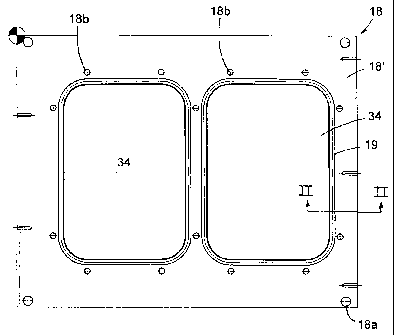Une partie des informations de ce site Web a été fournie par des sources externes. Le gouvernement du Canada n'assume aucune responsabilité concernant la précision, l'actualité ou la fiabilité des informations fournies par les sources externes. Les utilisateurs qui désirent employer cette information devraient consulter directement la source des informations. Le contenu fourni par les sources externes n'est pas assujetti aux exigences sur les langues officielles, la protection des renseignements personnels et l'accessibilité.
L'apparition de différences dans le texte et l'image des Revendications et de l'Abrégé dépend du moment auquel le document est publié. Les textes des Revendications et de l'Abrégé sont affichés :
| (12) Brevet: | (11) CA 2235266 |
|---|---|
| (54) Titre français: | SUPPORT PLAT POUR GARNITURE D'ETANCHEITE DE PLATEAU RECIPIENT ET SERTISSEUSE |
| (54) Titre anglais: | TRAY SEALING PLATEN AND SEAL APPARATUS |
| Statut: | Durée expirée - au-delà du délai suivant l'octroi |
| (51) Classification internationale des brevets (CIB): |
|
|---|---|
| (72) Inventeurs : |
|
| (73) Titulaires : |
|
| (71) Demandeurs : |
|
| (74) Agent: | BORDEN LADNER GERVAIS LLP |
| (74) Co-agent: | |
| (45) Délivré: | 2005-03-29 |
| (22) Date de dépôt: | 1998-05-19 |
| (41) Mise à la disponibilité du public: | 1998-12-02 |
| Requête d'examen: | 1999-05-28 |
| Licence disponible: | S.O. |
| Cédé au domaine public: | S.O. |
| (25) Langue des documents déposés: | Anglais |
| Traité de coopération en matière de brevets (PCT): | Non |
|---|
| (30) Données de priorité de la demande: | ||||||
|---|---|---|---|---|---|---|
|
Joint élastique périphérique, joint et support plat, le support plat comportant une cavité de logement de plateau récipient et une rainure périphérique entourant la cavité et logeant le joint. Le joint comporte des nervures latérales déformables lors de l'insertion dans la rainure, et un épaulement s'étendant au-delà de la rainure pour buter contre le support plat.
A peripheral resilient seal, and seal and platen, the platen having a container tray receiving cavity and a peripheral groove around the cavity and receiving the seal. The seal has side ribs deformable upon insertion into the groove, and a shoulder extending beyond the groove to abut the platen.
Note : Les revendications sont présentées dans la langue officielle dans laquelle elles ont été soumises.
Note : Les descriptions sont présentées dans la langue officielle dans laquelle elles ont été soumises.

2024-08-01 : Dans le cadre de la transition vers les Brevets de nouvelle génération (BNG), la base de données sur les brevets canadiens (BDBC) contient désormais un Historique d'événement plus détaillé, qui reproduit le Journal des événements de notre nouvelle solution interne.
Veuillez noter que les événements débutant par « Inactive : » se réfèrent à des événements qui ne sont plus utilisés dans notre nouvelle solution interne.
Pour une meilleure compréhension de l'état de la demande ou brevet qui figure sur cette page, la rubrique Mise en garde , et les descriptions de Brevet , Historique d'événement , Taxes périodiques et Historique des paiements devraient être consultées.
| Description | Date |
|---|---|
| Inactive : Périmé (brevet - nouvelle loi) | 2018-05-19 |
| Lettre envoyée | 2010-12-06 |
| Inactive : CIB de MCD | 2006-03-12 |
| Accordé par délivrance | 2005-03-29 |
| Inactive : Page couverture publiée | 2005-03-28 |
| Inactive : Taxe finale reçue | 2005-01-14 |
| Préoctroi | 2005-01-14 |
| Un avis d'acceptation est envoyé | 2004-07-28 |
| Lettre envoyée | 2004-07-28 |
| Un avis d'acceptation est envoyé | 2004-07-28 |
| Inactive : Approuvée aux fins d'acceptation (AFA) | 2004-07-12 |
| Modification reçue - modification volontaire | 2004-01-21 |
| Inactive : Dem. de l'examinateur par.30(2) Règles | 2003-08-19 |
| Lettre envoyée | 1999-06-16 |
| Modification reçue - modification volontaire | 1999-06-14 |
| Exigences pour une requête d'examen - jugée conforme | 1999-05-28 |
| Toutes les exigences pour l'examen - jugée conforme | 1999-05-28 |
| Requête d'examen reçue | 1999-05-28 |
| Demande publiée (accessible au public) | 1998-12-02 |
| Inactive : CIB attribuée | 1998-07-24 |
| Inactive : CIB attribuée | 1998-07-24 |
| Inactive : CIB en 1re position | 1998-07-24 |
| Symbole de classement modifié | 1998-07-24 |
| Exigences de dépôt - jugé conforme | 1998-06-29 |
| Inactive : Certificat de dépôt - Sans RE (Anglais) | 1998-06-29 |
| Inactive : Demandeur supprimé | 1998-06-26 |
| Demande reçue - nationale ordinaire | 1998-06-26 |
Il n'y a pas d'historique d'abandonnement
Le dernier paiement a été reçu le 2004-03-26
Avis : Si le paiement en totalité n'a pas été reçu au plus tard à la date indiquée, une taxe supplémentaire peut être imposée, soit une des taxes suivantes :
Veuillez vous référer à la page web des taxes sur les brevets de l'OPIC pour voir tous les montants actuels des taxes.
Les titulaires actuels et antérieures au dossier sont affichés en ordre alphabétique.
| Titulaires actuels au dossier |
|---|
| OLIVER PACKAGING AND EQUIPMENT COMPANY |
| Titulaires antérieures au dossier |
|---|
| PERRY R. DEYOUNG |